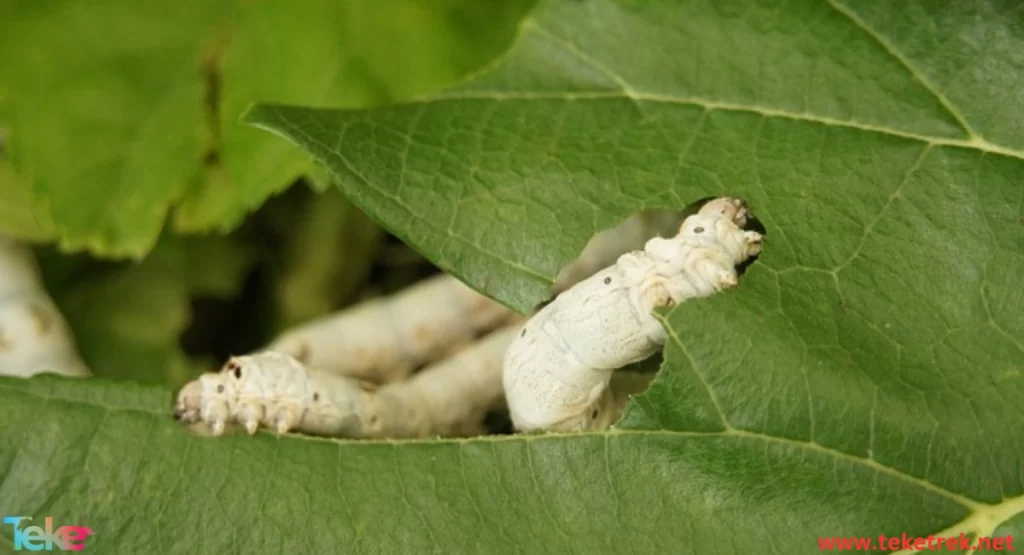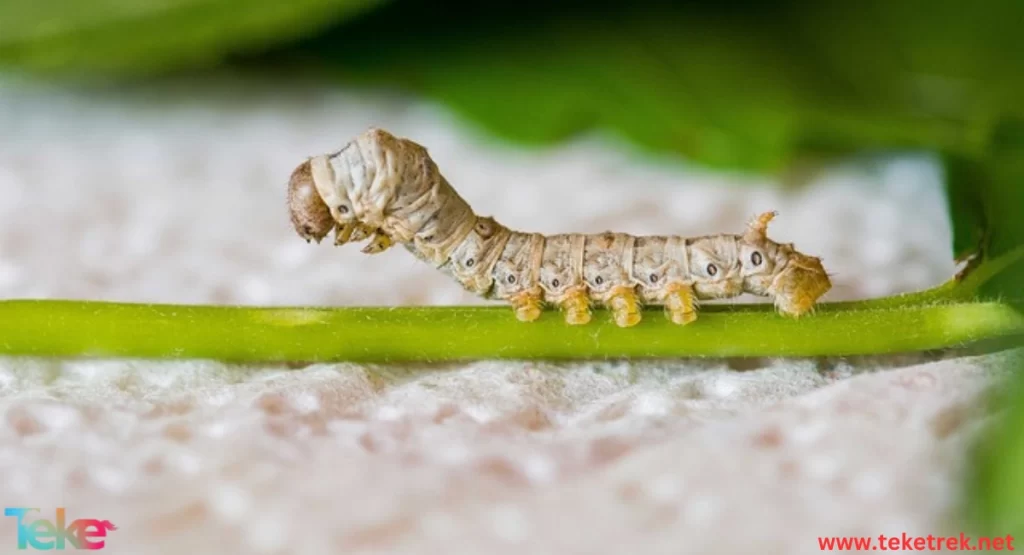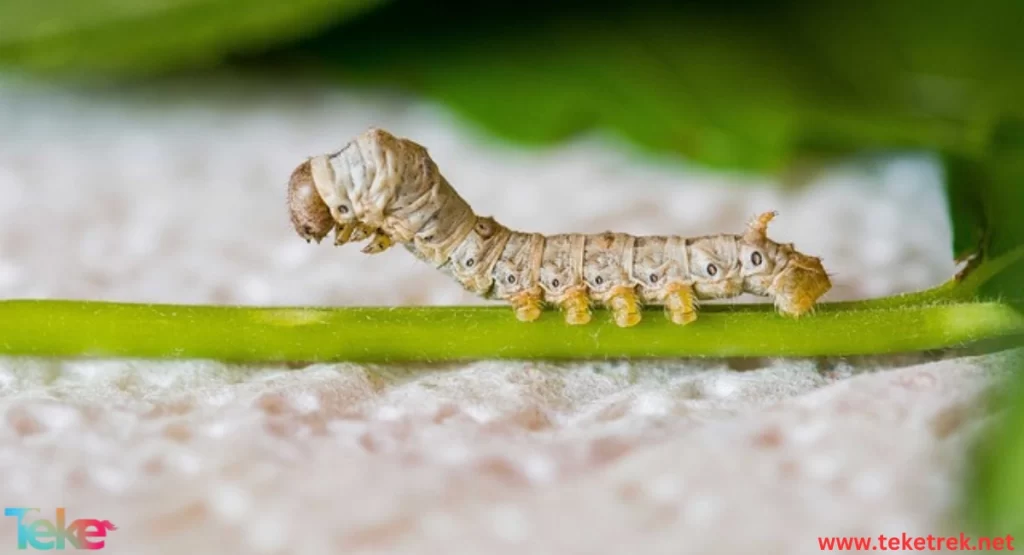The silkworm, also known as Bombyx mori, belongs to the family Bombycidae and is the primary producer of silk. It possesses salivary glands inside its mouth that release a viscous fluid called silk glands. These glands secrete a clear, sticky liquid that exits through openings called spinnerets. When this liquid comes into contact with air, it hardens.
Raising this type of worm is considered a profitable economic venture that contributes to community development and improves quality of life. We will talk more about Silkworm in TekeTrek Website.

Specifications of the Silkworm
Body and Color:
- The Silkworm is characterized by its rough and thick body, with colors ranging from blonde, yellow, to light brown.
Features:
- It also features dark bands extending along its body. Additionally, it possesses wings, each measuring 50mm in length.
Weight:
- The weight of a mature Silkworm ranges from 1.5 to 2.2 grams.
Head and Sensory Antennae:
- It has a conical-shaped head, a beak-like mouth, and large sensory antennae.
Facts about the Silkworm
- Silkworm produces silk and makes it in two types: cultivated silk and wild silk.
- It lives at a specific temperature and does not adapt to temperature variations or weather changes.
- It can lay a massive number of eggs, sometimes up to 400 eggs during the winter season.
- The butterfly dies immediately after hatching from the egg, and the male lives for a short period before dying.
- After hatching, it remains in a dormant state until the beginning of spring to feed on mulberry leaves.
- Males respond to the female’s scent by constantly fluttering their wings as they move towards the source of the scent, revealing half of the receptors in their antennae.
- In its early stages, Silkworm tolerates high humidity and grows stronger and healthier compared to late-stage larvae.
- It is sensitive to strong light, so it crawls towards dim light.
- Silkworm is known for its rapid growth, transforming into a pupa within approximately 25 days.
- Male Silkworm live longer than females, with the female’s life cycle being shorter, ranging from 5-10 days.
- Despite being voracious feeders, using food to produce silk threads, they may fast completely for a period ranging from 24 to 48 hours during certain stages.
- Silkworm sheds its skin regularly due to continuous growth.
Where does Silkworm live?
- Silkworm lives in cold environments, where it can be found in China, which is considered the native habitat of Silkworm
- It is widespread in Asia, Europe, North America, and South America. Additionally, it is abundant in India, as India is one of the strongest producers of clothing, wool, and silk.
Types of Silkworm
There are many types of Silkworm, each differing based on adaptation and other factors. The most important:
- Bivoltine Silkworm:
Also known as the dual-polar Silkworm, it is found in China, Korea, Japan, and East Asia. It’s named bivoltine because it produces silk twice a year.
- Univoltine Silkworm:
Primarily found in European countries, it’s named univoltine because it produces silk once a year.
- Polyvoltine Silkworm:
This type originates in tropical regions, with an incubation period ranging from 9 to 12 days. It is characterized by its abundant silk production due to multiple life cycles throughout the year.
- Muga Silkworm:
Found in Northeast India, it is known for the luster of its silk, which increases with age.
- Tasar Silkworm:
Its silk is known as tasar silk, characterized by its roughness, strength, and durability.
- Eri Silkworm:
Found in Japan, it produces large quantities of silk and primarily feeds on protein-rich castor leaves.
- Oak Tasar Silkworm:
Its silk is considered one of the finest types and is found in the Himalayan regions, feeding on oak leaves
What does Silkworm eat?
- The diet of Silkworm varies depending on its age. When it is born, it feeds on a massive amount of mulberry leaves, whether white, red, or black mulberry.
- Generally, it feeds on white mulberry leaves and some other types of plant leaves. The larvae also feed on lettuce leaves and orange leaves. They eat four times a day to produce the required amount of silk.
The Reproduction of Silkworm
- The fertilization process during mating season lasts for a period ranging from 6 to 12 hours.
- After 24 hours from fertilization, the female lays eggs, which can reach up to 400 eggs sometimes, and they are blue in color.
- It secretes a gum substance to ensure the stability of the eggs until the moment of hatching and the emergence of larvae.


The Life Cycle of Silkworm
1. Mating:
Lasts for 6 weeks until the weather moderates and mulberry leaves, which the larvae feed on, appear.
2. Egg Hatching:
When the weather becomes moderate, the larvae start breaking the eggs and coming out. This stage is extremely small.
3. Larva:
This stage continues for a period ranging from 24 to 33 days. The larva stage begins with the shedding of the black hair covering the worm’s body, which starts to grow.
4. Pupa:
After the larva reaches the stage of maturity, it begins to secrete silk and wrap itself in it, using it for two weeks in a stage called dormancy.
5. Butterfly:
This is the shortest stage in the Silkworm life cycle, where the butterfly lays its eggs and then dies immediately after.
Mechanism of Silk Secretion in Silkworms
In general, silkworms have salivary glands in their mouths that are specialized for secreting silk through several stages, explained as follows:
- Initially, the salivary glands produce a substance called fibroin, which is a special protein stored in liquid form.
- When the silkworm reaches the stage of cocoon formation or feels threatened, it begins to secrete this liquid through two openings in its mouth.
- This liquid dries as soon as it is exposed to air and transforms into solid silk threads.
- Finally, the worm repeatedly moves its head to form long silk threads.
The Importance of Silkworms in Maintaining Agricultural Environments
Silkworms are of great importance for both their economic and environmental benefits. They help in:
- Feeding primarily on mulberry leaves, which helps regulate the growth of these plants and maintains ecological balance.
- Acting as primary consumers in the food chain, making them a key food source for various animals, birds, and insects.
- Producing waste that serves as an organic fertilizer, enhancing soil quality and fertility.
Silkworms: How Diet Affects Silk Quality
The quality of silk is affected by the silkworm’s diet. The more nutritious the diet, the better the silk. Nutrients include:
- Fresh green leaves, rich in nutrients, such as mulberry leaves.
- High protein content, which increases the strength and thickness of the silk.
- Adequate food quantity, as more food leads to more silk production.
Genetic Modifications in Modern Silkworm Breeding Programs
Despite their natural capabilities, modern breeding programs aim to optimize silkworm performance. Key technologies include:
- Genetic Engineering: Inserting specific genes to improve traits like disease resistance or silk output.
- Selective Breeding: Choosing silkworms with desirable traits (e.g., large cocoons, high-quality silk) to reproduce.
- Molecular Techniques: Studying and improving genes involved in silk protein production.
Silkworms in Culture and History
Silkworms have been domesticated for thousands of years, and their uses have evolved over time:
- In ancient times, primarily used for silk production, especially in China, where they symbolized wealth and luxury.
- In the Middle Ages, their use expanded to high-end silk garment production.
- They became widespread in regions like Japan, Korea, and the Middle East, eventually becoming a part of global trade.
- Used in genetic research and biology innovations.
- Some silkworm parts have been used in traditional medicine for treating various diseases.
Enhancing Silk Production Using Modern Technology
Given their economic value, various technologies are now used to boost silk output:
- Molecular Techniques: Modifying silk-producing genes to improve silk quality and quantity.
- Smart Agriculture: Monitoring environmental conditions and improving water and food quality.
- Feed Improvement: Developing new plant-based diets enriched with nutrients to enhance silk production.
Factors Influencing the Color and Density of Silk
Silkworms do not all produce the same type or quality of silk. Key influencing factors include:
- The quality and type of food—more nutritious food yields denser and more vividly colored silk.
- Genetic traits—play a key role in silk color and thickness.
- Environmental conditions—like temperature and humidity can significantly affect silk production and quality.
- Maturity stage—affects the physical characteristics of the silk thread.
Silkworms as a Part of Biodiversity in Ecosystems
Silkworms play an essential ecological role:
- They are a primary food source for various birds and animals, helping maintain ecosystem balance.
- Aid in pollination of some plants.
- Their waste enriches soil fertility, supporting sustainable agriculture.
- Contribute to genetic diversity through breeding of different strains, enhancing ecological resilience.
Impact of Silkworm Farming on Local Economies
Silkworms have a vital impact on rural and local economies:
- Provide high-paying job opportunities in rural areas.
- Increase income for farmers, especially where agriculture is the main livelihood.
- Encourage traditional crafts by boosting demand for silk-based products.
- Promote sustainable development by relying on local resources and reducing imports.
Silkworms in Arts: Using Silk in Handicrafts
Silkworm-derived silk has many artistic and functional uses worldwide:
- Used in making luxurious clothing and high-quality fabrics.
- Acts as a base for painting or as a material for hand embroidery.
- Used in traditional carpets and furnishings.
- Forms accessories like scarves, ribbons, and belts.
Frequently Asked Questions about Silkworms
- How long does a silkworm live?
An adult silkworm can live from 5 to 10 days.
- How is silk extracted from silkworms?
Silkworms produce silk fibers when they spin a cocoon around themselves during their journey to become a butterfly. These ultra-soft fibers are harvested from the raw cocoon by boiling it in hot water and stirring until the cocoons unravel.
- Does the silkworm die after silk production?
In reality, the extraction process leads to the death of the silkworms. Boiling the cocoons kills the silkworms inside, leaving silk farmers with empty shells of silk threads.
- What is silkworm used for?
Silkworm larvae are a source of nutrients for humans such as protein, fats, minerals and vitamins. They are also used in the manufacture of health care products, medicines and animal feed.
At the end of the article, we are pleased to emphasize the importance of this insect in the production of silk, which we use in many aspects of our lives.






